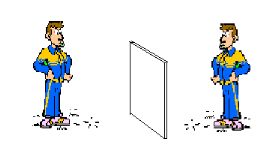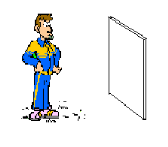2.3. Interpretation of the results
Out from our research, the results we came to can be
interpreted in the following way.
First, children aged 0 : 6 to 1 : 00 are capable to use
babbling, gestures to express what they see and feel. But they are still unable
to say really what they are. For example, Victor's production of " toto " from
his image in the mirror let us understand that he used babbling rather than
language. This behaviour is however a positive performance in terms of language
development because it is common to all children growing up normally to produce
" toto " at the early age.
Second, children who grow up positively and who could be
called advantaged ones acquire language more rapidly than those
disadvantaged.
Advantaged children have so many opportunities to learn even
things around them. They learn for example to use a mirror, a telephone or a
T.V. set.
These concrete materials can help these children acquire some
language and therefore happen to say and convince older people that they are
already separate individuals. At 2 : 3 and 2 : 6 already, Emma and Neema know
that they are " mie ",
" nie " and this is embodied in their whole persons to say
that they are individuals.
On the contrary, disadvantaged children who have no access to
such concrete things will not be capable to identify themselves through them.
We were happy to find that even at 2 : 00, Emile could not speak because,
despite his being unable to identify himself through the mirror, he has been
suffering from diseases and this affected his language development.
Our third interpretation of the results of our research is
the advantage and problem of self-dentity.
As an advantage, the " Mie ", "nie", " mi ", " na", "je", " I
", "me" once acquired help the person to live his personality and
individuality. Philemon, 6 : 00, for
example, knows that to be dirty can affect him because it
gives a negative picture of his identity. That is why when he says "
Minajichekea ju niko bucafu", he feels ashamed and therefore must go to
wash.
On the other hand, the disadvantage of the " I " of
self-identification is the egocentricity and selfishness of the person which to
our point of view, is negative.
Emma, 2 : 3, is a good example since he did not want to share
neither the mirror he had in hand nor his food with Justine because he knew
they were his and not for others. Likewise, Rosette, 3 : 9, referred to her
pencil as " ni yangu " knowing that it belongs only to her and not to her
younger sister Lucienne.
On the whole, up until when the child is unable to use the
first personal pronoun to identify himself as unique and individual, he will
not have evolved physically and therefore qualify linguistically fully. This is
to say together with Tanz (1980 : 89), quoted by Kambale, B.M. (2002-2003),
that
" the " I " is the acid test for homosapiens evolution and
evolvement to
humanhood.
Finally, the following are the statistical results we came
to.
Table 3 : Pourcentage of self-identification,
age-range indication.
|
Number of groups
|
Age-range in terms of months and years
|
Number of children selected
|
Self-identification as " I "
|
|
|
|
+
|
%
|
|
1.
|
0:6 - 1:5
|
3
|
0
|
0 %
|
|
2.
|
1 : 6 - 2 : 00
|
5
|
2
|
40 %
|
|
3.
|
3 : 00
|
4
|
4
|
100 %
|
|
4.
|
4 : 00 - 6 : 00
|
3
|
3
|
100 %
|
The sign + in this table means when the child happened to
produce the " I " of self-identification.
The results in this table show that at two years, only a few
children can identify themselves. Before this age, the child will only be using
nonverbal language. From two and beyond it, the child can now use his language
to be identified with.
The implication of these figures to the teaching and learning
of English by Congolese children is to design a syllabus , for example, for
kindergaten or primary school which is appropriate to their level of mastering
the language.
As some children aged 2:00 or 3:00 can be admitted at
kindergaten even if they cannot up to now identify themselves as «I»,
the teacher can use some procedures which would help them learn a bout the
«I» of their individualities. He can, for instance, make them use
gestures referring to themselves as follows:
Step 1: Child ______ Teacher

Teacher: Emile, Mie (Emile, Me)
Emile (repetition): Emile, Mie (Emile, Me)
Teacher : Mie, Emile (Me, Emile)
Emile : Mie, Emile (Me, Emile)
Etc.
Here the teacher shows Emile a mirror. He asks him to repeate
what the teacher makes him produce.
Step 2: Child _____ Child

Emile: Emile, Mie (Emile, Me)
Emile: Emile, Mie (Emile, Me)
Emile: Mie, Emile (Me, Emile)
Emile: Mie, Emile (Me, Emile)
The above repetitions of Emile, through the mirror, are a way
to help him aquire the first personal pronoun by himself. The teacher is only a
guide.
On the other hand, children growing up normally can be taught
and encouraged to use utterances like the following, in pair work
activities.
e.g.:Child 1: Mie Rosette, niko mwanafunzi (Me Rosette,
I'm a
pupil)
Weye Emma, hauko mwanafunzi (You Emma, you are
not a pupil)
Child 2: Mie Emma, niko garcon (Me Emma, I'm a
boy)
Weye Rosette, uko fille (You Rosette, you are a
girl)
These interactions will have each of the members of the group
not only identify himself as individual but also differentiate himself from
others.
| 


